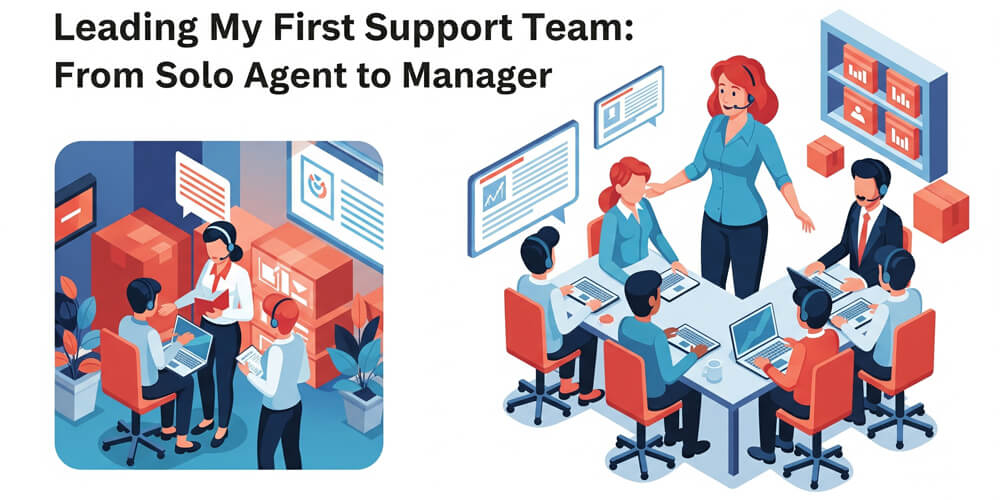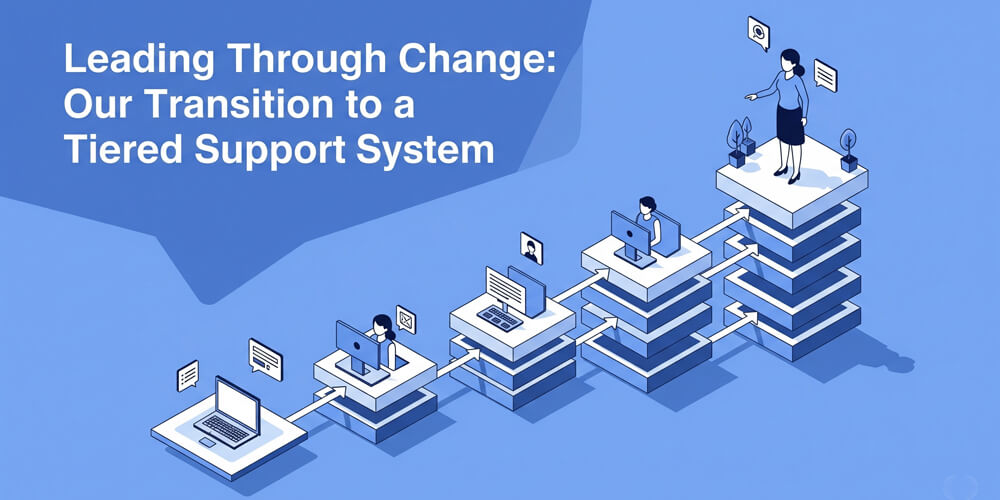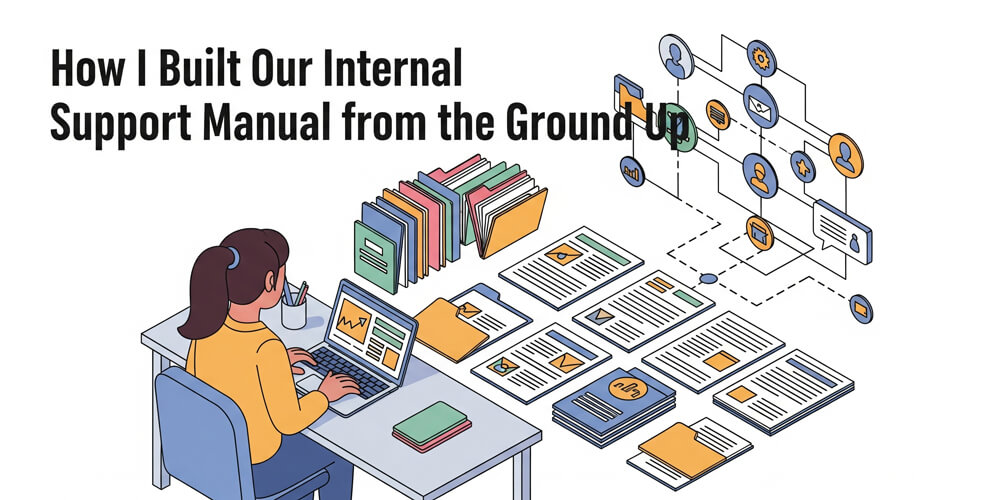Last year, I faced one of the most defining moments of my leadership journey during the chaos of Black Friday weekend. As the newly appointed Product Support Lead at WPManageNinja, I was no longer the solo problem solver. I was responsible for guiding a team through one of the busiest, most stressful periods in the WordPress ecosystem. What unfolded over those few days not only tested our technical skills but also challenged my understanding of what it truly means to lead. This story is about how stepping back and empowering my team led to a breakthrough, both for our support operation and for my own growth as a leader.
Table of Contents
Open Table of Contents
The Weight of Leadership
Black Friday isn’t just a retail event; for those of us in WordPress support, it’s a crucible. Last year, as the Product Support Lead for FluentCRM and FluentSMTP at WPManageNinja, I faced my first Black Friday weekend not as a solo troubleshooter but as the leader of a newly formed team of five agents. Having resolved over 5,000 support tickets myself, I was no stranger to the chaos of BFCM—site crashes, plugin conflicts, and frantic clients losing revenue by the minute. But this time, the stakes felt different. My team’s performance was a direct reflection of my leadership, and I was gripped by a new kind of anxiety: Could I trust my team to handle the pressure, or would I need to step in as the hero I’d always been?
In my earlier years as a freelancer and individual contributor, I thrived on being the go-to expert. Whether it was debugging a cron job failure or optimizing email deliverability for a high-volume WooCommerce store, I knew I could rely on my technical skills—honed through years of working with NGINX, Apache, AWS, and even my academic research hosting WordPress on an Android device. But leadership demanded something else: the ability to step back and let others take the stage. This Black Friday weekend would teach me that my real job wasn’t to save the day—it was to build a team capable of saving it themselves.
Preparing for the Storm
The weeks leading up to BFCM were a blur of preparation. I drew on my experience managing over 12,000 support responses and mentoring junior agents to create a robust system for my team. We developed an internal manual I’d been refining since joining WPManageNinja in 2022. It covered everything from common FluentCRM automation failures to troubleshooting FluentSMTP’s email deliverability issues under heavy server load. I also wrote detailed documentation for our plugins, now live at fluentcrm.com/docs and fluentsmtp.com/docs, to ensure agents could reference solutions quickly.
Training was equally critical. I ran mock scenarios with my team, simulating urgent tickets like checkout failures and cron job misfires. We practiced clear, empathetic client communication, a skill I’d mastered during my freelance days on Upwork, where I earned a Top Rated badge. I also set up a dedicated Slack channel for real-time collaboration. My goal was to empower my team to own their tickets, reducing the 42% escalation rate I’d seen in previous years when I was the primary problem-solver.
The Stress Test of a Support Team
When BFCM weekend hit, our support portal exploded. Tickets poured in: a WooCommerce store with a coupon code glitch, a site crashing under traffic spikes, and a FluentSMTP misconfiguration blocking transactional emails. My old self would have grabbed the keyboard and started debugging. Instead, I leaned on the playbook and watched my team spring into action.
The defining moment came on Saturday morning with a high-priority ticket from a major e-commerce client. Their FluentCRM post-purchase automations were failing—new customers weren’t being tagged, and their “Thank You & Upsell” email sequence wasn’t sending. This was a perfect storm, involving:
- A high-stakes, revenue-critical e-commerce client during peak sales.
- FluentCRM post-purchase automations not triggering for new customers.
- “Thank You & Upsell” email sequences failing to send.
- WordPress cron jobs overloaded or misconfigured due to heavy server load.
- Potential plugin conflicts affecting automation triggers.
- Site experiencing traffic spikes, increasing server resource contention.
- Urgent need for clear, empathetic client communication under pressure.
- Risk of lost sales and negative customer experience if not resolved quickly.
- Limited time to diagnose and implement a reliable, long-term fix.
- Coordination required among multiple team members to troubleshoot and resolve.
This combination of factors, all converging during BFCM’s peak traffic, made it a true test of our team’s skills and systems.
In the past, I’d have taken this ticket myself, diving into server logs and cron schedules like a detective. But this time, I stayed silent. I opened our Slack channel and observed.
The Team Work
Let’s talk about one example ticket.
The Slack notifications were relentless. Suddenly, a high-priority ticket landed in our queue: a major WooCommerce retailer—one of our largest clients—reported that their FluentCRM post-purchase automations had stopped working. New customers weren’t being tagged, and their “Thank You & Upsell” email sequence wasn’t sending. The client was losing out on crucial follow-up sales during the busiest shopping weekend of the year.
In the past, I would have jumped in immediately, combing through server logs and plugin settings myself. But this time, I paused and watched as my team took the reins.
The agent who claimed the ticket—a junior hire I’d onboarded just six months earlier—immediately posted a crisp summary in our Slack war room:
“High-value client, FluentCRM automation failure, likely cron overload. Site running WooCommerce, heavy BFCM traffic. Immediate revenue impact.”
Within minutes, another agent chimed in, linking to the “Server-Side Cron Jobs” section of our internal playbook (a resource I’d painstakingly built from years of troubleshooting WordPress performance bottlenecks). A third team member suggested checking the client’s caching setup, referencing a FluentCRM documentation article I’d published on avoiding cache conflicts with automation triggers.
The lead agent (A Tier III Agent) took charge of client communication, breaking down the technical issue in plain, empathetic language:
“Your site’s traffic is overwhelming the WordPress cron system, which is why emails aren’t sending. This is common during high-traffic events like Black Friday. We recommend setting up a server-side cron job for reliable automation.”
They then walked the client through each step:
- Disabling WP-Cron: Instructed the client to add
define('DISABLE_WP_CRON', true);to theirwp-config.phpfile. - Setting Up a Server-Side Cron: Provided cPanel screenshots and a sample cron command (
*/5 * * * * wget -q -O - https://example.com/wp-cron.php?doing_wp_cron >/dev/null 2>&1) to ensure WordPress tasks ran reliably, even under heavy load. - Verifying the Fix: Guided the client to trigger a test purchase and confirm that automations and emails fired as expected.
- Long-Term Recommendations: Suggested monitoring server resources and reviewing plugin updates post-BFCM to prevent recurrence.
Throughout the process, the team collaborated in real time—one agent double-checked the client’s FluentSMTP configuration to rule out email delivery issues, while another monitored server logs for PHP errors or timeouts.
The solution wasn’t just a quick patch; it was a robust, future-proof fix that ensured the client’s marketing automations would remain stable even as their business scaled.
The ticket was resolved in just 47 minutes, with zero input from me. The client replied with gratitude and left a glowing 5-star review later on WordPress.org, praising the agent’s “expertise, clarity, and calm under pressure.” As I read the review, I felt a surge of pride—not for solving the problem myself, but for building a team and a system that empowered others to deliver excellence when it mattered most.
The Realization: Leadership as Empowerment
That moment crystallized my true role as a leader. My value wasn’t in my ability to debug a cron job or optimize a server; it was in the systems I’d built and the people I’d empowered. The Support Playbook, the training sessions, the documentation I’d written for FluentCRM and FluentSMTP—these were my contributions, scaled through my team. By stepping back, I’d allowed them to step up, transforming a high-pressure moment into a shared triumph. I was always with them in spirit, guiding them through the playbook I’d created, but they were the ones executing with confidence and skill.
The team’s success wasn’t just a win for that ticket; it was a testament to the power of trust and collaboration. I realized that leadership isn’t about being the hero who swoops in to save the day; it’s about creating an environment where your team can shine, even under pressure. It’s about building processes that empower others to take ownership and make decisions, knowing they have the support and resources to succeed.
This realization marked a profound shift in my mindset. Leadership, I learned, is not about being indispensable in the trenches, but about architecting an environment where others can thrive and excel—even in the most demanding situations. The pride I felt wasn’t rooted in personal heroics, but in witnessing my team’s confidence, resourcefulness, and collaboration blossom under pressure. By investing in robust processes and fostering a culture of trust, I had multiplied my impact far beyond what I could achieve alone.
This wasn’t about being the charge; it’s about preparing the team to win. My technical background—configuring NGINX for WordPress, troubleshooting email deliverability with PowerMTA, or even running WordPress on an Android device for my B.Sc. thesis—had taught me to value precision. Leadership required a different kind of precision: crafting processes that multiplied my expertise across a team. The result? Our ticket resolution rate during BFCM doubled from 7.2 to 12.6 tickets per hour, escalations fell to 4%, and our CSAT score hit 4.8 out of 5 on WordPress.org platform.
Ultimately, the true legacy of leadership is not measured by the number of problems you solve yourself, but by the resilience, capability, and confidence you instill in your team. That Black Friday, I saw firsthand how empowering others creates a ripple effect—one that elevates not just individual performance, but the entire organization’s ability to deliver excellence, adapt to challenges, and sustain success over time.
I had the pleasure and thrilling experience of witnessing my team transform from a group of individuals into a cohesive unit, capable of tackling even the most daunting challenges with grace and skill. I am proud to mention that I was involved in hiring each of them(4) , train them from WordPress as a user to Wordpress as a basic developer who can troubleshoot common issues, and then to a support agent who can handle complex issues with confidence. I have shared the exciting experience of that team building from scratch in a dedicated blog post.
Lessons Learned
I like to think of leadership as conducting an orchestra. Each agent is a skilled musician, capable of their own solos but most powerful together. My job isn’t to play every instrument—I’ve done that as a freelancer, debugging apps or configuring AWS instances—but to set the tempo, align the sections, and let the team create something greater than the sum of its parts. That Black Friday, my team performed a symphony, and I was proud to be their conductor.
The Black Friday win didn’t just boost our metrics—it fundamentally reshaped my philosophy of leadership. Here are the core principles I took away, each forged in the heat of real-world challenges:
-
Build Systems, Not Solutions:
It’s tempting to swoop in and fix problems yourself, but that only helps one client at a time. By investing in robust playbooks, reusable documentation, and internal tools, you empower your team to solve issues independently and at scale. For example, our internal support manual and public docs meant agents could resolve complex automation failures without waiting for my input—multiplied impact, less bottleneck. -
Trust Over Control:
Micromanagement stifles initiative and erodes confidence. I learned to step back, even when the stakes were high, and let my team take ownership. This trust paid off: agents collaborated, shared knowledge, and delivered under pressure. The result was not just faster resolutions, but a team that grew in skill and self-assurance with every challenge. -
Invest in People:
Training and mentorship are force multipliers. By onboarding agents thoroughly—from WordPress basics to advanced troubleshooting—and providing ongoing feedback, I turned raw potential into high performance. The transformation I witnessed in junior hires, who went from nervous first responders to confident problem-solvers, was the most rewarding part of my role. -
Codify Success:
Every win is a blueprint for future victories. After resolving the automation ticket, I turned the solution into a training module, complete with annotated screenshots and a Loom walkthrough. This not only accelerated onboarding for new hires but also ensured that our collective knowledge was preserved and accessible. -
Celebrate Collectively:
Recognition fuels motivation. When the client left a glowing 5-star review, I made sure to spotlight each agent’s contribution in our team meeting and internal channels. Publicly celebrating wins reinforced a culture of shared achievement and encouraged everyone to keep raising the bar.
These lessons resonate deeply with my ongoing work at WPManageNinja, where products like FluentCRM (60,000+ active installs) and FluentSMTP (400,000+ active installs) depend on user trust and exceptional support. The surge in 5-star reviews—35+ for FluentCRM and 80+ for FluentSMTP in 2024 alone—reflects not just my individual efforts, but the collective capability and spirit of our empowered team.
By focusing on systems, trust, and people, I’ve learned that leadership is less about personal heroics and more about creating an environment where excellence becomes the norm—no matter how high the stakes.
Turning Wins Into Growth
The automation ticket became more than a victory; it became a teaching tool. I transformed it into a training module for new hires, complete with screenshots and a Loom video. This reduced onboarding time and we’ve since resolved similar issues faster. I also updated our FluentCRM documentation to include a user-facing guide on server-side cron jobs, which has been viewed a lot of times and cut related tickets by 15% or more approximately.
This approach—turning wins into repeatable processes—reflects my technical mindset. Whether it’s writing QA scripts for FluentForms (FluentForms QA with Codeception) or contributing to WordPress support forums (profiles.wordpress.org/ibrahimsharif) or (Snippets for WPManageNinja Products), I believe in building solutions that last.
Avoiding Pitfalls: Leadership Lessons Learned
Leadership is a journey, and I’ve learned that it’s not just about guiding your team through challenges but also about avoiding common pitfalls. Reflecting on my experience during that Black Friday weekend, I realized that effective leadership requires constant vigilance and a commitment to continuous improvement. Here are some key lessons I’ve learned to avoid the traps that can undermine a leader’s effectiveness:
In the WordPress community, where plugins like FluentCRM and FluentSMTP power thousands of businesses, support leadership means scaling human expertise. Empowered teams drive faster resolutions, higher CSAT, and organic growth through positive reviews—key for SEO and reputation. My experience aligns with great companies, where ownership and collaboration are core values. By building resilient teams, we create value that lasts.
Leadership isn’t without pitfalls. Here’s how I’ve learned to avoid them:
- Micromanaging: I resisted taking over tickets by tracking my interventions (down to zero during that key BFCM ticket).
- Neglecting Documentation: Our playbook’s “success” pages ensure we’re always prepared.
- Skipping Debriefs: Post-BFCM, we analyzed what worked and updated our manual, boosting future readiness.
- Ignoring Stress: I checked with my team’s self-reported stress levels. I do not want my team members to stress too much.
- Hogging Credit: I publicly credited my team on Slack and LinkedIn, reinforcing their ownership.
- Failing to Set Clear Expectations: I made sure every agent understood their responsibilities and escalation paths.
- Overlooking Individual Strengths: I assigned roles based on each agent’s unique skills, such as technical troubleshooting or client communication.
- Not Providing Timely Feedback: I gave real-time feedback during and after the event, helping agents learn and improve quickly.
- Delaying Recognition: I celebrated wins immediately, both privately and publicly, to reinforce positive behaviors.
- Underestimating the Value of Process: I documented not just solutions, but the decision-making process, so the team could handle novel issues confidently.
- Ignoring Cross-Team Collaboration: I encouraged agents to reach out to developers or product managers when needed, breaking down silos.
- Not Planning for Scale: I reviewed our systems post-event to ensure they would support a larger team or higher ticket volume next year.
Black Friday taught me that leadership is about enabling others to succeed. The true measure of a leader isn’t how many fires you put out yourself, but how many people you empower to solve problems, innovate, and grow. Watching my team rise to the occasion—solving complex issues, supporting each other, and delivering outstanding results—was a powerful reminder that the greatest impact comes from building others up.
This experience fundamentally changed my perspective. I realized that sustainable success is built on trust, systems, and a culture where everyone feels ownership. The ripple effect of empowerment goes far beyond a single event: it shapes team morale, customer satisfaction, and the long-term health of the organization. As leaders, our legacy is not the number of tickets we close, but the confidence, skills, and resilience we nurture in those around us.
If you’re on your own leadership journey—whether you’re leading a team of two or two hundred—remember: your most important job is to create an environment where others can thrive. Invest in your people, codify your knowledge, and celebrate every win, big or small. The results will speak for themselves, not just in metrics, but in the stories your team will tell about how they grew under your guidance.
What about you? When has your team surprised you with their brilliance, or taught you something new about leadership? I’d love to hear your story—share it in the comments below, or connect with me checking the reviews of my team’s effort on WordPress.org in LinkedIn to continue the conversation about building high-performing, empowered teams in the WordPress ecosystem and beyond.
Let’s keep learning, growing, and inspiring each other to lead with empathy, vision, and purpose. The future of leadership is collaborative—let’s build it together.




